December 31, 2004
MISSION TO EARTH
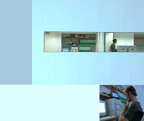
Soft Cinema
MISSION TO EARTH (Soft Cinema Edition), A Media Installation by Lev Manovich: What kind of cinema is appropriate for the age of Palm Pilot and Google? Automatic surveillance and self-guided missiles? Consumer profiling and CNN? To investigate answers to this question, Lev Manovich - one of today’s most influential thinkers in the fields of media arts and digital culture – has paired with award-winning new media artist and designer Andreas Kratky to create the Soft Cinema project. They have also invited contributions from such other leading cultural figures as DJ Spooky, Scanner, George Lewis and Jóhann Jóhannsson (music), servo (architecture), Schoenerwissen/ Office for Computational Design (data visualization), and Ross Cooper Studios (media design).
Lev Manovich will present Mission to Earth in The Project Room @ Chelsea Art Museum, New York, NY – from January 8 through January 26. The exhibition includes a public reception, the release presentation of Soft Cinema: Navigating the Database DVD, and a panel all taking place on Saturday, January 8, 2.00 – 4.30pm, 2004.
MISSION TO EARTH (Soft Cinema edition) is a science fiction allegory of the immigrant experience that adopts the variable choices and multi-frame layout of the Soft Cinema system to represent ‘variable identity’. In this gallery installation the film is being assembled in real-time by the Soft Cinema software from a large database of media elements. While the narrative stays the same and repeats every 23 minutes, all other elements can potentially change. As a result, there is no single ‘unique’ version of the film – every run produces a new
version.
SOFT CINEMA: Navigating the Database is the Soft Cinema project’s first DVD publication published and distributed by The MIT Press (2005). It presents three ‘films’, including Mission to Earth, that were created within the framework of the project. Although the ‘films’ on the DVD reference the familiar genres of cinema, the process by which they were created and the resulting aesthetics fully belong to the software age. They demonstrate the possibilities of software) cinema - a 'cinema' in which human subjectivity and the variable choices made by custom software combine to create films that can run infinitely without ever exactly repeating the same image sequences, screen layouts and narratives.
Lev Manovich, the leader of the Soft Cinema project and the videographer, editor, and author of Mission to Earth, is an internationally recognized leader in the field of new media culture. He is the author of The Language of New Media (The MIT Press, 2001) and Little Movies (1994), the first film project created specifically for the World Wide Web. His computer-driven installations and films have been exhibited in numerous museums, galleries, media and film festivals in the US, Europe and Asia, including ZKM, Karlsruhe; the ICA, London; SENEF, Seoul; and the ICC, Tokyo. In addition, Soft Cinema received an honorary mention at Transmediale 2003 festival, Berlin and is the subject of a short documentary by ARTE-TV.
Andreas Kratky, the author of the Soft Cinema software, has been responsible for media design and co-direction of a number of groundbreaking new media projects, including the award-winning DVDs That’s Kyogen and Bleeding Through – Layers of Los Angeles 1920-1986 (both published by ZKM).
FURTHER INFORMATION
Soft Cinema Project
Complete text used in Mission to Earth
OPENING AND PANEL DISCUSSION at Chelsea Art Museum SATURDAY January 8, 2:00 - 4:30 PM with:
Lev Manovich, associate professor of new media, University of California, San Diego
Christiane Paul, adjunct new media curator, Whitney Museum of American Art
Barbara London, curator, video and digital media, Museum of Modern Art
Sue Hubbard, art critic, Independent Newspaper, London
Ken Feinstein, artist/professor of experimental video
WHERE: Chelsea Art Museum is at 556 West 22nd Street, at the corner of 11th Avenue. Take the E or 1, 9 to 23rd Street.
HOURS: Chelsea Art Museum is open Tuesday - Saturday, Noon – 6 PM; Thursday to 8.
TICKETS: Events are FREE with museum admission: $6 for adults, $3 for students and seniors. Thursdays $3 for everyone. Free admission for members and visitors 18 and under.
Posted by jo at 07:01 PM | Comments (0) | TrackBack
December 27, 2004
netzwissenschaft
![]()
Emerging Infrastructures of All (Inter)net Research
Dr. Reinhold Grether's network research | netzwissenschaft site maps the "emerging infrastructures of all (inter)net research endeavours. net.science as an anthropology of connectivity is trying to overcome the constraints of specialist method transfers on net matters. the protuberance of technical networks necessitates a professionalization of human net knowledge. neither the isolation of concepts as in basic research nor the encapsulation of processes as in applied sciences will ever be able to adequately describe the complex autopoiesis of networks. net.science is undoubtedly developing into a scienza nuova of its own right."
Check out his Mobile Art and Virtual Performance research areas.
Posted by jo at 04:45 PM | Comments (0) | TrackBack
December 01, 2004
Station House Opera project

A Global Event of a Different Order
DOMESTIC SPACE needed for use as development and performance location for STATION HOUSE OPERA. New project LIVE FROM PARADISE is a global internet project that breaks new ground in live performance. Three events around the world, each with its own local audience, are linked by video streaming to create a combined performance that is presented at each location as a live movie projected on two screens, edited together in real time.
Each location is unique and has a single camera, which can move from the performance space itself to other places in the building or the surrounding streets. Close-ups, views from windows, street scenes, views of hidden rooms, all from different places, are linked to form a single narrative.
The house/flat/space will be needed for a year from April 2005, as the piece will be tailor-made and rewritten to fit the specific location, whilst the other two performances travel from Brazil to Berlin, Japan to Amsterdam. If you know of a possible location or want more information about the project, please contact Alex Hyde, alex @ artsadmin.co.uk
Live from Paradise is an event which aims to make the ordinary, physical existence of distant performers close, immediate, unpredictable and alive. By joining the physically present performers with performers in remote locations, via the visual language of a narrative film, shot and edited in real time, the audience is confronted with a global event of a different order - one which makes a performance while questioning their own understanding of film, video and live broadcasting.
Live from Paradise will be performed in three apartments simultaneously. In each of the three places the audiences will see the live performance along with video streamed from the other two locations, projected on two screens placed side by side.
Posted by jo at 10:06 AM | Comments (0) | TrackBack
November 24, 2004
Mulholland Drive
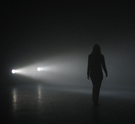
cinema sans image
In Mulholland Drive by D. Scott Hessels, three artists drove Los Angeles' famous Mulholland Drive with five types of sensors—measuring tilt, altitude, direction, speed, and engine sound. The captured data was used computationally to control two robotic lights in a dark room filled with fog. Two beams of light and the processed sound of the engine recreated the topology of the road as a new form of visual experience and sculpture—cinema without image.
Mulholland Drive is a light installation that translates the movement across a topology as two beams of light. Instead of direct human interaction, the work takes the sensed data (tilt, sound, and GPS) of traversing an environment and recreates the drive through angles, light, and sound. A passive interactive experience, the artwork emphasizes the spatial quality of light—it is cinema without image. Like cinema, direct data is captured, then edited, and shaped. However, here the environment directly defines the experience, using the geography computationally. In a sense, “Mulholland Drive” is a new media Earthwork and demonstrates how suddenly the rhythms, patterns, and random chance of the environment can be sensed through new media technologies and used to create new forms of visual experience.
Producing under the name Damaged Californians, Scott Hessels has released experimental art and commercial projects in several different media including film, video, web, music, broadcast, print, and performance for the last decade. His work has shown in international film and new media festivals, on television, and in contemporary art galleries. He recently completed a commission of three interactive films and six online movies for Australia and was honored with a career retrospective at the Melbourne International Film Festival. As a media artist, his installations have shown at CiberArt in Bilbao, the Hammer Museum in Los Angeles, and the Japan Media Arts Festival. Professionally, as Director of Information Technology for Fox Television, he was responsible for the systems, software, communications, and security for two television stations and two cable networks…a career he followed for 25 years. He currently teaches digital video at UCLA in the Design | Media Arts Department and is studying for his graduate degree in that field.
Posted by jo at 01:00 PM | Comments (0) | TrackBack
November 06, 2004
Time [Re]Sequenced

user dependent cinema
PLACE--a year long series of exhibitions that explore the role of networked technologies in transcultural experience, organized by MediaNoche-- presents the first exhibition in the series. Time [Re]Sequenced (Networked Cinema) is a project by Cyril Tsiboulski which explores the ways traditional cinematic structure can be affected by new media.
Time [Re]Sequenced is a screen based interactive project in which a four minute scene from Solaris (1972), a Russian film directed by Andrey Tarkovsky, is broken into individual frames by the users accessing the project site. The sequence is then reconstructed and played back using shots initiated by the users. Time [Re]Sequenced depends on and responds to the virtual participation of the audience. A unique network driven algorithm creates a new space and a new language of cinema. Edited in real time, the film sequence can only be reconstructed as a result of audience participation. It depends on the network traffic volume thus creating potentially endless variations. As a contributor to the cinematic structure, but a passive viewer of the result, an audience member is challenged to re-think the role digital technology plays in how we experience our culture.
November 5th - 24th, 2004; Opening reception: FRIDAY, NOVEMBER 5th from 6 - 8p.m.; MediaNoche is located at 161 East 106th Street, New York City.
DIRECTIONS: Take the 6 subway to 103rd Street and walk north along Lexington Avenue to 106th Street. Turn right on 106th Street. MediaNoche is on the north side of the street in the middle of the block.
HOURS: The gallery is open Tuesday through Saturday, from 3PM to 7PM. Appointments can be made by calling 212 828 0401.
http://www.networkedcinema.org
Posted by jo at 10:00 AM | Comments (0) | TrackBack
October 14, 2004
iCinema

Immersive and Interactive Narrative
The iCinema Centre for Interactive Cinema Research, established in 2001, is a joint venture of the College of Fine Arts and the School of Computer Science and Engineering at the University of New South Wales, Sydney. It brings together researchers and postgraduate students in new media, digital cinema, digital aesthetics, film theory, multimedia design, computer science, artificial intelligence and software/hardware engineering.
The iCinema research program focuses on the research and development of a digitally expanded cinema. This includes all forms of the moving image, made visible on any type of screen or in any sort of immersive environment, whose structure is constituted by various methods of narrative coherence. The project is directed by Jeffrey Shaw and Dennis Del Favero.
The Centre has four principal research domains:
Immersive Visualization Systems: The exploration of immersive environments which provide for the collection, integration and display of visual, audio and kinesthetic data.
Distributed Interface Systems: The integration of interface systems with the experience of distributed spatial visualization environments.
Interactive Narrative Systems: The exploration of interactive narrative systems which provide the viewer with the ability to select and edit interaction with a set of visual narrative streams.
Theories of Interactive Digital Narrative Systems: The inquiry into theories of narrative and the organization of units of meaning and experience within the digital domain.
Posted by jo at 12:55 PM | Comments (0) | TrackBack
October 13, 2004
Cinéma
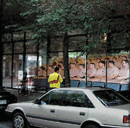
Shuttled Between Worlds
Cinéma is a multi-artist, cross-disciplinary performance presented in a storefront, converted into a theatre which looks out onto an urban streetscape. The audience inside this theatre watches and listens to video and sound elements while live performance takes place on the street outside. Narrative elements in Cinéma are in both French and English. Cinéma opens with texts which deal with the nature of the first word, the dominance of the ‘cinematic eye’ in our experience of the world, and the fragility of the human body. The myth of Orpheus and Eurydice, with its shuttle across the transitional space between the worlds of the living and the dead, is used as a structuring device for the piece.
Cinéma will be presented at SAT (Society for Art and Technology/La Societé des arts technologiques), 1195 rue Saint-laurent, Montréal [between René-Levesque et Sainte-Catherine - métro: Saint-Laurent]; October 12-15, 2004 at 8pm. During the day visitors can sit in the theatre observing the street while listening to an audio piece in which fragments of the performance soundtrack are adapted as an installation.
Thematically, the use of the myth is of interest in examining the very contemporary problem of the ability of art to influence the unfolding of events. What is the use of art in the face of political and social conditions which appear to be beyond our control? Can art create a window onto invisible forces which seem to control our lives? Can it open a process which allows us to approach spiritual and existential questions without falling into romantic clichés? In short, what is the potential relevance of art beyond its contemporary relegation to the role of diversion and entertainment?
Music: Rainer Wiens
Texts: Shauna Beharry, Andrew Forster
with: Monique Romeiko, Robert Schweitzer, Solomón Díaz, Michael Fernandes, Nathalie Claude
Posted by jo at 09:33 AM | Comments (0) | TrackBack
September 22, 2004
Geo-Cinema

Embedding GPS in Moving Images
"If we can send a picture of a place, why wouldn’t we want someone else to find exactly the same spot? The same angle? The same longitude and latitude? The same Place." Being On Location: The beginnings of a Geo-Cinema & Location-aware video recording. See also: Get Carter 1971 Location List & Days in the Country & Photo recognition software gives location & RAW What happened in that minute before you took a picture? (=place) & this MDVR from March Networks & Data and Narrative: Location Aware Fiction.
originally posted by thomas, 04.11.04 on angermann2.
Posted by jo at 11:21 AM | Comments (0) | TrackBack
September 15, 2004
Elastic Test
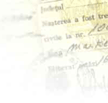
eliminate undesirable foreigners
Immigration authorities around the world need our help!! Use this website to contribute your ideas or proposals for an elastic test that can be devised to eliminate undesirable foreigners.
Immigration Statutes around the world are generally written using vague or abstract notions such as good moral character. It is the messy job of the courts to make such abstractions concrete, to objectively test and measure the moral character of a foreigner, and to eliminate arbitrary or contingent factors from the immigrations process. Join us in doing our part. We will invent, develop and implement numerous elastic tests, which can help the authorities contain and eliminate undesirable foreign bodies. Some of these tests will then be executed on our foreign test subject in a series of live and webcast performances.
Robert Lawrence (UNIMAS, Sarawak, Malaysia and USF, Tampa, Florida) wrote to us about this project on July 22, 2004. He said:
This project from the beginning has had an open door for participation through the web, but currently we are looking for ways to decentralize the project in more significant ways. Some issues related to this on which we are cogitating:
1. Given that our interventions require location-specific collaborations, how can the role of trans-local media, networks or distribution channels be re-imagined?
2. How can the project become less centralized? What are some models of de-centered cooperation we can try to implement – what is the advantage of a distributed network of creators in this case?
3. How might considerations of distribution and re-usability expand the current scope of the work?
4. One of the important aspects of the work is initiating and facilitating new relationships between local communities and structures – is this sustainable?
As we continue to evolve this project and develop ways to ‘turn it loose’ we are very interested in engaging in dialogue, theoretical and practical collaborations, and discovering and developing new models for distance collaboration.
Another of Lawrence's projects Un Message, Evidemment was blogged here.
Lawrence had this to say about it:
"The ‘story’ will be told entirely in the recorded messages that the foreground characters are listening to on their cell phones. These stories will be selected, synthesized and/or adapted from the contributions at this website and other venues. These stories will be gathered in several ways. Whenever the film in progress is shown at festivals, workshops or any other venue people will be asked to contribute storys by phone, sms, email. Participants will be encouraged to engage the performance on any number of levels.
We are also seeking opportunities to workshop the film doing shooting or writing. The “completed” film provides another dimension of the viewer/performer dynamic. At every stage of production, post-production, and presentation the ‘final form’ of the film will be negotiable. It will be shown in a user interactive form on the web, and in ‘concrete,’ though varying, versions in festivals and the usual film art venues – It may not ever appear in the same form twice."
Posted by jo at 08:46 AM | Comments (0)
September 10, 2004
Textual @traction

Audience gets the message
In the new movie about text messaging--Textual @traction--audiences "will be able to see the messages exchanged between leading characters-on their own mobiles...The film centres on a young man who finds a lost mobile phone and starts replying to text messages from a mystery stranger...What makes the film unique is that the audience does not actually get to see the messages on screen...Instead, by pre-registering, they receive the texts to their own phones at the same time as the characters on screen." Karen Price, The Western Mail, Sep 9 2004. Textual @traction has been selected to compete for Best Short Film, Best Foreign Film and Best Drama, at this year's Los Angeles International Short Film Festival. Posted by emily 09.09.04 | 05:54 PM on textually.org
Posted by jo at 10:09 AM | Comments (0)
August 20, 2004
Un Message, Evidemment...
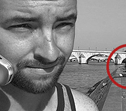
Cell phone portraits
Un Message... is an ongoing film and performance. The performance actions are built around the activity of making an interactive collaborative film. The film is a story about communication. The performance is a communication about story.
The film is already shot. The film has not been written. The film will be written through mobile phone lines, voice messages, sms’s, email, conversations, random overheard snatches of dialogue and any other sounds produced by the participants of various festivals, seminars, workshops and by visitors to this web site.
Posted by jo at 11:20 AM | Comments (0)
help me make it through the night
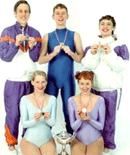
Acting Out
help me make it through the night, brought to you by the Gob Squad...
"In the blue, dead hours of night, four people return to their hotel rooms. None of them can sleep, instead they kill time in cold baths or by finding comfort in the solace of the hotel mini bar. Each is being watched by a surveillance camera, sharing their moments of fear and boredom as they sit out a long and sleepless night. In the conference room of the hotel the audience watches the four performers on a fourway split screen projection. In the anonymity and discretion of the hotel environment the performers will enact forbidden games and unlived desires at the request of the audience."
Posted by jo at 02:00 AM | Comments (0)
July 31, 2004
More Distributed Cinema
Lev Manovich's Soft Cinema
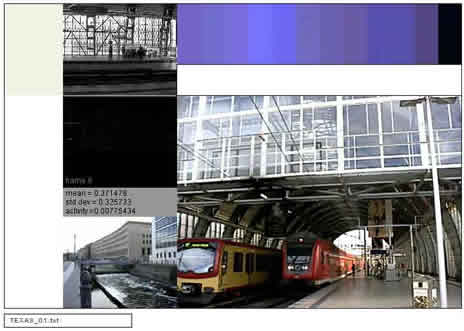
Soft(ware) Cinema is a dynamic computer-driven media installation. The viewers are presented with an infinite series of narrative films constructed on the fly by the custom software. Using the systems of rules defined by the author, the software decides what appears on the screen, where, and in which sequence; it also chooses music tracks. The elements are chosen from a media database which at present contains 4 hours of video and animation, 3 hours of voice over narration, and 5 hours of music.
Affective
Cinema
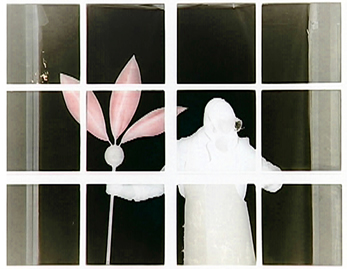
Affective Cinema is an interactive video installation.
The order and parameters of image and sound shown on the video are influenced according to the visitor’s measured emotional response to displayed video clips. Players see more important video scenes; the stronger they react, the more they understand of a secret system, where abstract characters and objects tell a situation of social dependencies and connections.
There is an abstract spatial situation: only elements like windows, doors, cars, etc. are placed in a wide unlimited white space – no walls or environmental elements. The sound has the important function to create that space in the human mind and to cause additional emotional reactions.
Posted by michelle at 07:16 PM | Comments (0)
Mobile Culture-Scratching
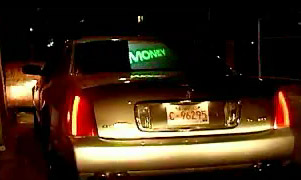
VJ-Fleet
by Julie Andreyev, at New Forms Festival 2003, consists of 3 cars fitted with video projection on the rear windshield. Each car has a theme determined by the character of the car, and by characteristics of the host city where the fleet is mobilized. The choice of cars for the project reflects the specific car culture of the host city expressed through customization and branding.
Mobile Equipment
The cars are set up with equipment to allow for mobile video downloading, and video mixing using data from the car. While the fleet is mobile, videographers in the downtown site are creating videos for projection on the cars. The themes are used as a guide for them to create footage of the activities of a city's inhabitants.
Networked Process
This footage is uploaded by the videographers onto a web server. Then, the footage is downloaded by the cars as they drive by WIFI (wireless internet) download sites. A sound artist records ambient sound using a microphone held outside the window of one of the cars, mixes this, and plays it back using an FM transmitter. Nearby cars can tune into our frequency and hear the audio sampling. Each car is equipped with a sensor and software patch that interprets data from the car.
Software Interface
For example, one sensor reads data from the engine speed. This data causes a kind of 'jittery' effect to be applied to the video. The faster the car revs, the more 'jittery' the video. In this way, not only are the inhabitants of the city portrayed, but also the car is expressed in the video. After the performance, the cars can be driven into a gallery space where they can be set up to project their archive of the evenings' videos.
Mobile Portrait of the City
The goal of this project is to create a mobile portrait of the city through video and audio sampling of real time events. VJ-Fleet relies on current VJ (or video jockey) culture and the hosting city's local car and social culture. For each performance the project is customized and scaled to reflect the particular nature of the host city.
Posted by michelle at 06:37 PM | Comments (0)
July 30, 2004
Distributed Cinema
SPEC-FLIC
Described by Adriene Jenick as a "Speculative Distributed Cinema Project....a series of fictional events performed as distributed cinema. SPEC-FLIC is a platform for speculation, creative experimentation and imagination among UCSD students, faculty, staff and the larger public. SPEC-FLIC's title refers to speculative fiction (an area of science fiction that is focused less on new science/tech and more on societal impacts) as well as to the size (a "speck") of the PDA-based video frame that serves as the conduit for this durational collective performance. Originally described as a distributed science fiction soap opera in three phases."
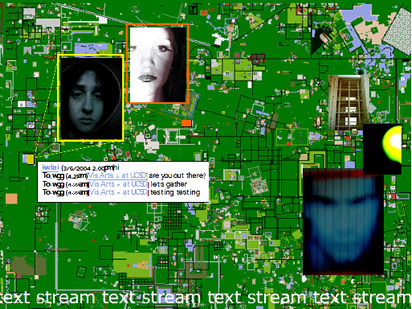
Adriene, tell us about this image.
What is the technology and experience behind this work?
Would you speak about the progression of your work from Paper Tiger television to Desktop Theatre on the internet to Active Campus and Spec Flic on the wireless network?
In your initial post you note these ongoing issues. Can you discuss them by way of examples from your work?
- timing/pacing/duration
this can be thought of from the perspective of participants or from "viewers" - in my experience the "lags" and glitches are all absorbable within the context of a live event. The archiving of this work does not allow for its tension to exist
- relationship of writing to performing, or textuality and orality
this is hugely fascinating to me especially considering the constant evolution of written and spoken language
- use of agitprop to catalyze unexpected engagements
all of my work is engaged within the larger "publc sphere" and cedes a large amount of control to the folks who are engaging with it.
Regarding SPEC-FLIC, your blog shows you in the midst of testing equipment. What are you testing? What is your creative process for working with technology and networks?
Posted by michelle at 09:42 PM | Comments (0)

